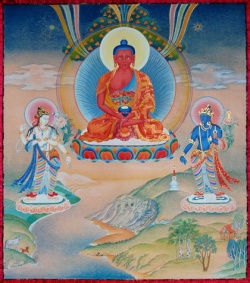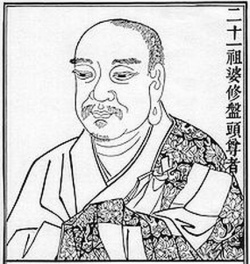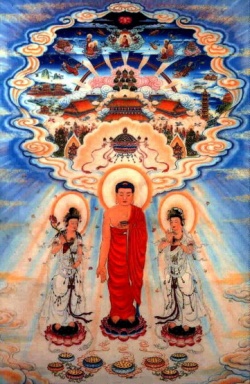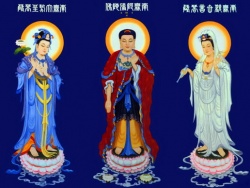Yogacara Theory - : The Nature of Reality
1. Explanation of the Threefold Nature
The Tri-svabhava-nirdesa is an extremely significant treatise written by the Yogacara master Vasubandhu, consisting of thirty-eight stanzas explaining the concept of the three natures (trisvabhava) or three distinguishing characteristics (trilaksana).
It is primarily an exposition of the ontological basis of the subject/object dichotomy as understood in terms of the Yogacara view, and is very important because it answers fundamental questions raised concerning how we view the world in which we live. Vasubandhu aim is to show that the subject/object dichotomy that exists between the emerging All-ground Consciousness (alaya-vijnana) and the ground of all phenomena (dharmadhatu) is born from a misapprehension of a single reality (tathata).
That which misapprehends this greater reality are all sentient beings born in the world, but the root of the misapprehension is created by the all-ground consciousness itself, which acts as a spell enchanting beings into believing in the facticity of the world in which they live.
The three intrinsic natures posited by Vasubandhu are:
The conceptually-constructed (parikalpita) nature;
the contingent (paratantra) nature, and
the actual (parinishpana) nature.
This theory was put forward to explain not only the illusion of the world that we see around us, but how that unreality is created. We find that the world is the product of not one, but three simultaneous realities.
The world that is perceived (and for it to be perceived, there must be a subject/object dichotomy) is described as a perceptual construct (kalpana), or conceived world, in the sense of something that isn't there being perceived or thought to be there. Insofar as it is a perceptual construct, its nature is said to be conceptually-constructed (parikalpita). This projection as such occurs as a simultaneous arising (e.q., see Yogacara II) of subject (ghahika) and object (grahya).
Vasubandhu asserts that the conceptually-constructed (parikalpita) nature of reality, by virtue of precisely what it is, has to be unreal (asat) and nonexistent; it is an illusion (bramti, deceit).
Nevertheless the conception that occurs—the experience of the subject/object dichotomy—is a play of various existent causes and conditions.
This contrivance (vikalpa) of various causes and conditions, is described as the contingent (paratantra) nature of reality. Behind that play of causes and conditions, there must be an underlying actual (parinishpanna) nature. The actuality is the unreality of the contrived construct.
The ultimate reality (dharmata) on which these three natures are imposed, almost like veils, is defined as Tathata (Tib: de-bshin-nyid, "that-is-ness"), pure noumenon.
But this explanation is not as simple as it may seem to be at first. To elaborate, Vasubandhu resorts to an analogy.
He says, let us consider a situation in which a magician, using certain spells (mantras) or tricks, was to cause, before a crowd of spectators, a log of wood to appear as an elephant. The fact that no elephant is there, but nevertheless is seen to be there by the audience, may be defined as the elephant's parikalpita-nature. In that sense the spectators imagine or project something that factually is not present.
The elephant is no more than a magician's illusion and yet the elephant is indeed seen. The hallucination (akrti), the illusion that is seen, of the elephant by the crowd may be defined as the situation's paratantra-nature. This means that the appearance of the illusion itself must be contingent on something else.
Finally, if we consider what the elephant really is in its self (i.e., a suggested image that isn't really there) then it's actual non-existence is its ultimately true or actual (parinishpanna) nature.
Vasubandhu then explains his analogy as follows: the All-ground Consciousness (alaya-vijnana) is the magic spell, with which cosmic ideation (visva-vikalpa), the Magician, magically produces the illusion of a Universe, and in which duality (dvaya) of subject and object becomes the result. The elephant is the Universe that appears to us as real. The original log of wood which has been misapprehended as the illusory elephant is the Tathata, the Absolute, that ever remains unchanged and pure from the beginning.
"With the non-apprehension of duality, the appearance of duality collapses, and with this collapse, the actual nature is realized as the non-existence of duality." — Trisvabhavanirdesa, verse 33.
Thus the nature (svabhava) of reality is ultimately nondual, which means that neither an apprehender (grahika) nor objects to be apprehended (grahya) exist as such.
2. Profound Contemplation of Reality
Sankara's reference (vide Brahmasutra Sankarabhasya) of "rope and snake" is a simple version of Vasubandhu's elephant analogy given above. The noble 9th century mystic Shankara, in introducing his system of Adwaita Vedanta, suggested that the world is like falsely seeing a snake for what actually is a harmless segment of rope. The rope is lying on the ground.
Dusk has gathered and it is not easy to see clearly. An observer, walking along the path, mistakes a short segment of rope lying on the ground for a poisonous cobra and takes fright. In this manner, says the great sage Shankaracarya, the world and its suffering is perceived, when in reality it is the pure Absolute (brahman) alone that exists.
In Shankaracarya's explanation, the world is purely illusion (maya). When the illusion is seen for what It truly is, just as the snake instantly becomes again the rope which it always has been, so too the world instantly transforms back to Brahman.
By this means Shankara likewise posited nonduality (adwaita). Hence his teaching is frequently known by the name Adwaita Vedanta.
Vasubandhu's explanation is, however, intrinsically more scientific than Shankaracarya. Shankara's analogy of "rope and snake" overlooks the antithesis of an absolute reality opposed to an absolute illusion, or existence (sat) versus non-existence (asat). Although Sankara and Vasubandhu are pointing in the end to the same final fact, Shankara's analysis of the problem falls short of Vasubandhu's. If we apply Vasubandhu's three natures to the rope and snake analogy we can arrive at a deeper insight into the whole problem.
Like the elephant that was not there, the snake is an illusion super-imposed on the rope. The rope is the Ultimate Reality not seen by us. What Shankara's explanation lacks, is in telling us how the illusion occurs.
This, you might say, he takes for granted. Vasubandhu, on the other hand, makes it clear that we have to accept that the illusion itself is contingent (paratantra) on something deeper. This something is revealed when the actual nature (parinishpanna-svabhava) of the illusion is seen for what it is, i.e., as non-existent.
To say the world is an illusion is insufficient, insofar as in doing so we impart to the concept illusion a reality that is not there. It is not that the world is an illusion, rather it is that the illusion itself is unreal, which is more important. The collapse of this projection is what breaks the spell imposed by the magician over the crowd.
Chatterjee and Datta, in An Introduction to Indian Philosophy, Calcutta 1968, present the argument as follows:
"The magician is a juggler only to those who are deceived by his trick and who fancy that they perceive the objects conjured up. But to the discerning few who see through the trick and have no illusion, the juggler fails to be a juggler. Similarly, those who believe in the world-show think of God through this show and call Him its Creator, etc. But for those wise few who know that the world is a mere show, there is neither any real World nor any real Creator."
The key, therefore, to Vasubandhu's message rests on contemplating the nature of Parikalpita, the imposition of the illusion on the Real (tathata).
3. Manjusrimitra's Final Comment
Manjusrimitra, author of the Bodhicittabhavana, adds a final comment to Vasubandhu's exposition. He says:
"Not recognizing [the hypnotic power] of finite contrivance (vikalpa), living beings are seduced by these very constructs, and since the continuum of conceptual-constructs flows [temporarily], there is no turning back from the deceit (bramti) later on.
"They who are deceived by Illusion's (maya) illusion, which is like the projected apparition of an elephant conjured up by a magician, are similar to sleepers who, drawn by the attraction of a lustful dream, are made subject to the power of that dream."



